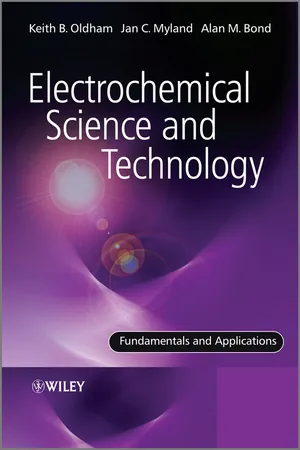
Electrochemical Science and Technology
Fundamentals and Applications
- English
- ePUB (mobile friendly)
- Available on iOS & Android
Electrochemical Science and Technology
Fundamentals and Applications
About this book
This book treats electrochemistry as a science in its own right, albeit resting firmly on foundations provided by chemistry, physics, and mathematics. Early chapters discuss the electrical and chemical properties of materials from which electrochemical cells are constructed. The behavior of such cells is addressed in later chapters, with emphasis on the electrodes and the reactions that occur on their surfaces. The role of transport to and from electrodes is a topic that commands attention, because it crucially determines cell efficiency. Final chapters deal with voltammetry, the methodology used to investigate electrode behavior. Interspersed among the more fundamental chapters are chapters devoted to applications of electrochemistry: electrosynthesis, power sources, "green electrochemistry", and corrosion.
Electrochemical Science and Technology is addressed to all who have a need to come to grips with the fundamentals of electrochemistry and to learn about some of its applications. It will constitute a text for a senior undergraduate or graduate course in electrochemistry. It also serves as a source of material of interest to scientists and technologists in various fields throughout academia, industry, and government – chemists, physicists, engineers, environmentalists, materials scientists, biologists, and those in related endeavors.
This book:
- Provides a background to electrochemistry, as well as treating the topic itself.
- Is accessible to all with a foundation in physical science, not solely to chemists.
- Is addressed both to students and those later in their careers.
- Features web links (through www.wiley.com/go/EST) to extensive material that is of a more tangential, specialized, or mathematical nature.
- Includes questions as footnotes to support the reader's evolving comprehension of the material, with fully worked answers provided on the web.
- Provides web access to Excel® spreadsheets which allow the reader to model electrochemical events.
- Has a copious Appendix of relevant data.
Frequently asked questions
- Essential is ideal for learners and professionals who enjoy exploring a wide range of subjects. Access the Essential Library with 800,000+ trusted titles and best-sellers across business, personal growth, and the humanities. Includes unlimited reading time and Standard Read Aloud voice.
- Complete: Perfect for advanced learners and researchers needing full, unrestricted access. Unlock 1.4M+ books across hundreds of subjects, including academic and specialized titles. The Complete Plan also includes advanced features like Premium Read Aloud and Research Assistant.
Please note we cannot support devices running on iOS 13 and Android 7 or earlier. Learn more about using the app.
Information








Table of contents
- Cover
- Half Title page
- Title page
- Copyright page
- Preface
- Chapter 1: Electricity
- Chapter 2: Chemistry
- Chapter 3: Electrochemical Cells
- Chapter 4: Electrosynthesis
- Chapter 5: Electrochemical Power
- Chapter 6: Electrodes
- Chapter 7: Electrode Reactions
- Chapter 8: Transport
- Chapter 9: Green Electrochemistry
- Chapter 10: Electrode Polarization
- Chapter 11: Corrosion
- Chapter 12: Steady-State Voltammetry
- Chapter 13: The Electrode Interface
- Chapter 14: Other Interfaces
- Chapter 15: Electrochemistry with Periodic Signals
- Chapter 16: Transient Voltammetry
- Appendix
- Index